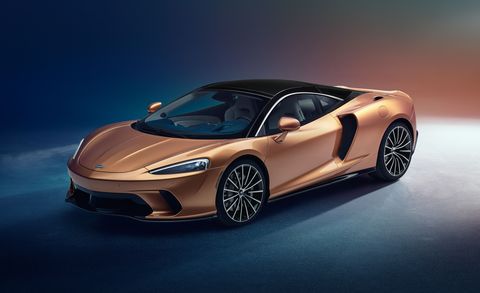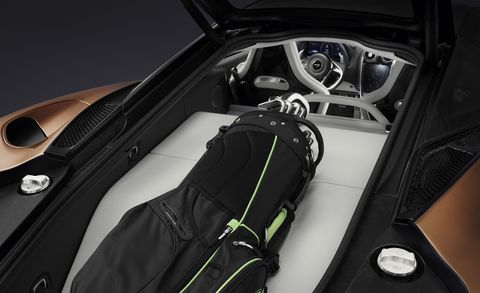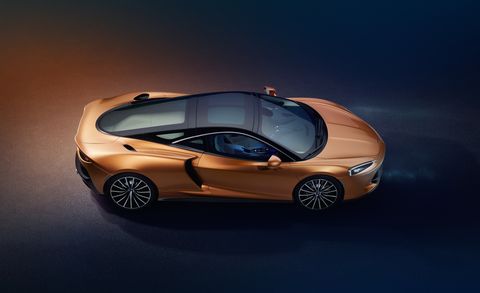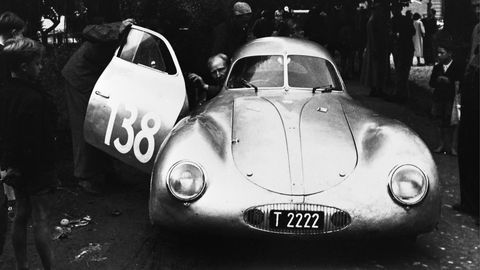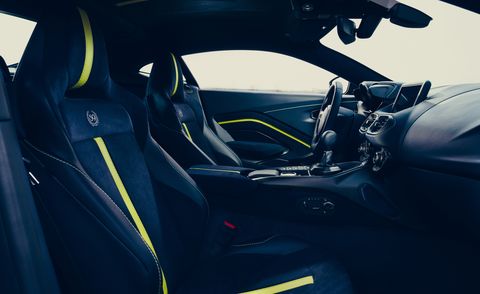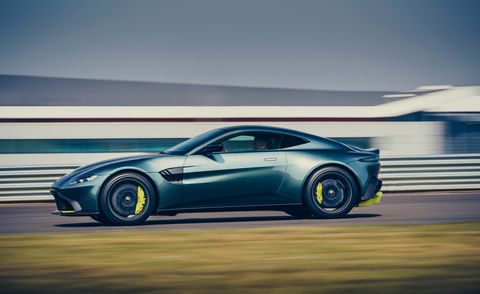Aston Has Built a Bond-Themed DBS Superleggera
Aston Martins shouldn’t really try to ram home the James Bond connection so explicitly, should they? After all, most sentient beings are well versed in the irrefutable fact that James Bond = Aston Martin. And vice versa.
Exhibit A: this new ‘On Her Majesty’s Secret Service DBS Superleggera’,which references 50 years since, well, On Her Majesty’s Secret Service was first released into cinemas. You may or may not remember, in that 1969 film James Bond (George Lazenby) drove a DBS. In Olive Green.
And lo, this new DBS Superleggera gets an Olive Green paint job too. Which is good, because green is a good car colour. Don’t @ us.
Elsewhere, the OHMSS DBS features wild, intricately designed forged alloys (diamond-turned, no less), much carbon fibre, an aero blade and a new splitter. The grille gets six horizontal vanes for a better homage to that 1969 movie car.
Inside, it’s black leather with red striping, some Alcantara, and the option of a bespoke drinks case that slots into the boot. Naturally, there are badges all over the place to remind you that yes, James Bond = Aston Martin. And vice versa. At some point, you will have to explain these badges to someone.
The 2020 BMW M5 Edition 35 Years Is a Subtle Tribute

When the BMW M5 first came to the US in 1986, you could only have it in black. A subtle treatment for one of the fastest four-doors the world had yet seen, and a car that established a legend. To celebrate 35 years of M5—Europeans first got this model in 1984—BMW has created the M5 Edition 35 Years, with subtle looks that seem to pay tribute to the E28s the company brought to America.
Only one shade is available for this car—Frozen Dark Grey II, a matte paint. The wheels are painted graphite gray, while the kidney grilles, brake calipers and tailpipes are black. And around back, you’ll find no M5 badge. Those who not in the know will just think this is a grey sedan; not the monster it is in reality.
Inside is where things get lavish. There’s gold anodized aluminum trim grained to look like carbon fiber, and full leather interior with stitching to match the trim. The center console is engraved with “M5 Edition 35 Jahre” to let passengers know just how special this car is.
The M5 Edition 35 Years is based on the M5 Competition, which packs a 617-hp 4.4-liter twin-turbo V-8 with an eight-speed automatic and a clever all-wheel drive system. It comes standard with the M Driver’s Package, which bumps top speed from 155 to 189 mph, and all the luxury and safety goodies you get with the M5’s otherwise-optional Executive Package.
BMW will make 350 examples of the M5 Edition 35 Years, and 35 of those will come to the US. The price is set at $129,000 including destination and the M5’s mandatory Gas-Guzzler tax. A similarly equipped M5 Competition would set you back $122,000, and you could always take the badge off the back. You won’t get the gold trim, though.
The 2020 McLaren GT Is a Mid-Engined Supercar Built for Luxurious Grand Touring
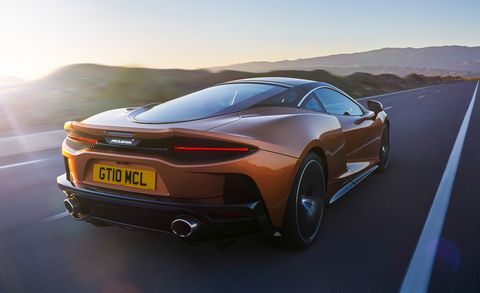
England’s posher automakers seem to be engaged in an artillery duel. Recently, Aston Martin has announced plans to launch two mid-engined supercars clearly aimed at Ferrari, Lamborghini, and McLaren, as previewed by the AM-RB 003 and Vanquish concepts. Now McLaren seems to be getting its retaliation in first with a car whose luxurious mission is implicit within its name: the GT.
Of course, McLaren has used GT branding before, but the outgoing 570GT was a member of the brand’s entry Sports Series. The new GT—which stands for Grand Tourer—is a model in its own right, and McLaren says it doesn’t fit into the existing model hierarchy of Sports, Super, and Ultimate Series. We’re promised it will offer unprecedented levels of both practicality and comfort, despite having a mid-mounted powerplant in a part of the market where cars traditionally stow their engines up front.
The GT’s most obvious disadvantage is its relative lack of passenger accommodation. In a segment where almost every significant rival offers at least plus-two practicality it remains a strict two-seater; the massively more expensive three-seat Speedtail remains the only McLaren for those who want to travel with more than one passenger.
But it is definitely the most practical McLaren yet. Underneath, the GT sits on a modified version of McLaren’s carbon-fiber tub, the Monocell-T (for Touring). This incorporates an additional carbon frame at the rear, which allows for the large hatchback that gives access to the luggage space positioned above the engine.
While this is similar in principle to the compartment that sat at the back of the 570GT, the new rear luggage space is much larger: 14.8 cubic feet, according to McLaren, which makes it capable of accommodating both a full-size set of golf clubs and two flight bags at the same time. That’s why the decision was taken to move away from the 570GT‘s side-hinged glass cover to a more conventional rear-hinged tailgate.
“It’s much easier to put something heavy in from the back than the side,” Tom Taylor, McLaren’s global product manager, said as he talked us around the car. The tailgate will also come with the option of power operation, a first for McLaren. With an additional 5.3 cubic feett of volume in the front compartment, the GT has more room for luggage than any competitor.
While the GT won’t have the interconnected hydraulic dampers of the more expensive 720S, it does get active shock absorbers under the control of what McLaren calls its Proactive Damping Control system, which are able to react to changing road conditions in as little as two milliseconds. We’re told to expect the most compliant ride from any McLaren, even on standard 21-inch rear wheels (with 20s at the front). Ride height has been increased over other McLarens, with a minimum of 4.3 inches of clearance under the car and a 10-degree approach angle beneath the front splitter, reducing anxiety about expensive grinding noises.
Power comes from a reworked version of the 4.0-liter twin-turbo V-8, as seen in the 720S, with sufficient changes to have been awarded a new design code: M840TE. The engine has new smaller turbochargers to improve responsiveness at lower speeds. Peak power is 612 horsepower at 7500 rpm, but although the maximum 465 lb-ft of torque arrives at 5500 rpm, Taylor says the GT has been engineered to be happy when operating at a scant percentage of its potential, with 95 percent of the torque peak already present at 3500 rpm.
The exhaust soundtrack has been engineered to have the bass-heavy harmonics that buyers reportedly associate with grand tourers. Refinement hasn’t come at the expense of performance, which will still be brutal. McLaren quotes a 3.1-second zero-to-60-mph time, a 9.0-second zero-to-124-mph time, and a 203-mph top speed.
According to McLaren design director Rob Melville, the GT has been styled to have a “less intense visual appearance” than its sportier sisters. It is longer than both the 570GT, with an overall length of 184.4 inches making it 6.1 inches bigger. It is only slightly taller though, at 47.8 inches, so only half an inch—with Melville saying much of his design team’s effort was expended on giving it the visual heft more appropriate to a grand tourer with a higher nose and clean surfacing.
Less demanding aerodynamic targets have allowed the GT to have some cleaner design; its doors don’t have the integral air channels of the S-suffix models, and both front and rear bumpers have more structure and less gap.
“It’s not about chasing drag targets or huge power,” Melville says. “What we wanted for the GT was a very simple, clean, bold design.”
By: Mike Duff, May 15, 2019
For more on the McLaren GT, visit: https://www.caranddriver.com/news/a27458479/2020-mclaren-gt-photos-info/
Source: https://www.caranddriver.com/
The Oldest-Surviving Porsche Will Probably Fetch $20 Million at Auction
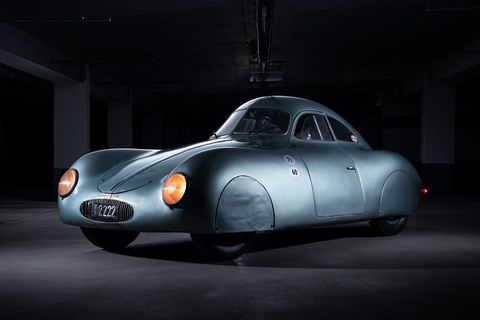
In a press release announcing the upcoming sale of the car you see here, auction house RM Sotheby’s declares it “the most significant surviving piece of Porsche engineering and design history.” It’s hard to argue with that, since this is believed to be the oldest-surviving Porsche. It’s so old, it actually predates the company by nearly a decade.
This car is a Type 64, which Ferdinand Porsche designed for a 1500-kilometer race between Berlin and Rome planned for September 1939. It was based on the Porsche-designed Volkswagen Beetle—then known as the KdF Wagen—but fit with streamlined aluminum body panels and a hotter 32-hp flat-four. The race never happened. Nazi Germany invaded Poland in September, 1939, and the Type 64 project was effectively cancelled. One car was built, which became property of the German government.
Ferdinand’s son Ferry built two more examples of the Type 64, though. Chassis #2 was completed in December, 1939, and chassis #3 was finished the following June. Type 64 #3 actually used the bones of the first car, which was crashed by the managing director of Volkswagen. While Type 64 #2 didn’t survive the war, chassis #3 did, and was retained by the Porsche family when they relocated to Austria. Ferry Porsche put the company name on the front of the Type 64, registered it in 1946, and had Battista “Pinin” Farina—who later founded design house Pininfarina—restore it in 1947.
In 1948, Porsche debuted its first car, the 356, and during an early appearance in Austria, Type 64 #3 was at its side. Austrian racer Otto Mathé bought the car from the company in 1949, and raced it extensively in the early 1950s. Mathé kept the car for the rest of his life, and shortly after he died in 1995, it was sold to Dr. Thomas Gruber, himself a Porsche historian.
In August, RM Sotheby’s will auction Type 64 #3 in Monterey, and it’s expected to command at least $20 million. It’s totally original, and it comes with a number of spare parts, too.
To become the most expensive Porsche ever, it has to beat the 917K used in the film Le Mans, which fetched $14 million at auction in 2017. Given its significance and only-one-left status, we expect Type 64 #3 to do so with ease.

In a press release announcing the upcoming sale of the car you see here, auction house RM Sotheby’s declares it “the most significant surviving piece of Porsche engineering and design history.” It’s hard to argue with that, since this is believed to be the oldest-surviving Porsche. It’s so old, it actually predates the company by nearly a decade.
This car is a Type 64, which Ferdinand Porsche designed for a 1500-kilometer race between Berlin and Rome planned for September 1939. It was based on the Porsche-designed Volkswagen Beetle—then known as the KdF Wagen—but fit with streamlined aluminum body panels and a hotter 32-hp flat-four. The race never happened. Nazi Germany invaded Poland in September, 1939, and the Type 64 project was effectively cancelled. One car was built, which became property of the German government.
Ferdinand’s son Ferry built two more examples of the Type 64, though. Chassis #2 was completed in December, 1939, and chassis #3 was finished the following June. Type 64 #3 actually used the bones of the first car, which was crashed by the managing director of Volkswagen. While Type 64 #2 didn’t survive the war, chassis #3 did, and was retained by the Porsche family when they relocated to Austria. Ferry Porsche put the company name on the front of the Type 64, registered it in 1946, and had Battista “Pinin” Farina—who later founded design house Pininfarina—restore it in 1947.
In 1948, Porsche debuted its first car, the 356, and during an early appearance in Austria, Type 64 #3 was at its side. Austrian racer Otto Mathé bought the car from the company in 1949, and raced it extensively in the early 1950s. Mathé kept the car for the rest of his life, and shortly after he died in 1995, it was sold to Dr. Thomas Gruber, himself a Porsche historian.
In August, RM Sotheby’s will auction Type 64 #3 in Monterey, and it’s expected to command at least $20 million. It’s totally original, and it comes with a number of spare parts, too.
To become the most expensive Porsche ever, it has to beat the 917K used in the film Le Mans, which fetched $14 million at auction in 2017. Given its significance and only-one-left status, we expect Type 64 #3 to do so with ease.
By: Chris Perkins, May 13, 2019
For more cars, visit: https://www.roadandtrack.com/car-culture/classic-cars/a27455508/oldest-porsche-type-64-no-3-auction/
Source: https://www.roadandtrack.com/
This Mad BMW 2002 Has a 792bhp V10 and Weighs Less Than a Tonne
However, that was nothing. Oh no, that little Z4 was just a tame little pup in comparison to the presumably angry Rottweiler that is Gruppe5 Motorsport’s latest creation. The renderings you see above will come to life this summer, and yes, that will be a real BMW 2002 underneath the mother of all carbon body kits.
But why the comparison to the Manhart Z4? Well, the Gruppe5 2002 will also use the S85 V10 from the E60 M5. However, customers will only be able to spec their car in either 5.8-litre, 734bhp trim, or 5.9-litre, 792bhp trim. Crikey.
To cope with all the power (which heads to the rear wheels only) the chassis of the old 2002 will be completely rebuilt by hand using a mixture of carbon fibre and steel, and an FIA-spec roll cage will also be fitted along with a 6-speed sequential gearbox. These cars will be designed as just-about-road-legal racers.
Thanks to all that carbon-fibre, the car will weigh just under one tonne, and thanks to that insane aero it’ll produce around 1.1 tonnes of downforce. Driving on the ceiling anyone?
There’s no word on cost as of yet, but you’ll need to provide your own original 2002 to qualify for the conversion, so don’t expect to be able to fund it by rooting down the back of your sofa. The plans are ambitious though – Gruppe5 expects to build 300 of the things.
The engines will be built by legendary BMW race tuner Steve Dinan, whilst the design will be led by Bill and Bob Riley, who have won 13 overall Daytona Prototype championships as a pairing. So there’s pedigree.
You just would, wouldn’t you?
By: Greg Potts, May 8, 2019
For more cars, visit: https://www.topgear.com/car-news/modified/mad-bmw-2002-has-792bhp-v10-and-weighs-less-tonne
Source: https://www.topgear.com/
The Aston Martin Vantage AMR Brings Back the Manual Transmission
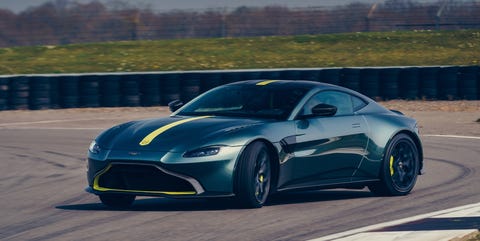
Last week, we told you that a new AMR version of the Aston Martin Vantage will have a manual transmission and that it will be “coming soon.” Well, it turns out that “soon” is already here. Aston has revealed the Vantage AMR, and as we suspected, it uses a seven-speed manual transmission with a dogleg-style first gear.
The transmission was developed by Graziano and was first used in the V12 Vantage Sfrom a few years ago. The racing-inspired dogleg setup means second through seventh gears are in a traditional H pattern, but first gear is down and to the left while reverse is up and to the left, the opposite of a traditional manual gearbox. It has what Aston calls Amshift, which is a rev-matching system that also allows for full-throttle upshifts; the system can be turned on or off. In addition to the gearbox, the AMR also gets a limited-slip differential that was developed by Aston’s racing team.
The AMR is said to weigh 209 pounds less than a regular Vantage thanks to the removal of the automatic transmission and the fitment of carbon-ceramic brakes as standard, and weight distribution is a perfect 50/50 split. (An automatic 2019 Vantage we tested weighed in at 3726 pounds.) While power from the V-8 is unchanged at 503 horses, torque has gone down from 505 lb-ft to 461 lb-ft (both peaking at 2000 rpm). Aston’s quoted zero-to-60-mph time for the AMR is slower than the regular Vantage’s, too, at 3.9 seconds for the AMR versus 3.5 for the standard car. Top speed remains 195 mph.
In addition to the manual transmission and its accompanying leather-wrapped shifter, the AMR gets a handful of cosmetic enhancements. New 20-inch forged aluminum wheels look like those on the Rapide AMR, and the brake calipers are painted to match other trim pieces in Lime Green, which is the AMR signature color. The design of the carbon-fiber side vents is new, and the hood gets a pair of new carbon-fiber vents. The AMR also features a bunch of standard kit that’s optional on regular Vantages, including a sport exhaust system with quad pipes, sport bucket seats, and lots of dark interior and exterior trim.
Only 200 AMRs will be built, with the first 141 coming in China Grey, Onyx Black, Sabiro Blue, or White Stone paint with a choice of four interior schemes—Aston calls the specs “designer specifications.” The AMR will start at $183,081, or $30,000 more than the standard Vantage. The final 59 cars in the AMR’s run are dubbed Vantage 59; these will feature a special color and option combination (shown in these photos) that celebrates Aston’s 1959 Le Mans win, similar to the recently revealed DBS 59. Those 59 cars will cost $208,081 to start.
If you’re not one of the lucky 200 people that will receive a Vantage AMR—and given how quickly models like this sell out, you probably aren’t—don’t fret. Aston says that the regular Vantage will gain the AMR’s manual transmission as an option beginning in the first quarter of 2020, once all the AMRs have been sold. There’s no word as to whether the manual will be a no-cost option, an extra-cost option, or actually cheaper than the automatic.
In speaking about the AMR’s conception and the new manual option, Aston CEO Andy Palmer says he has always promised that Aston would offer a manual in its lineup—it’s something that customers were asking for. The Vantage thus honors that promise and “sets [Aston] apart from [its] competitors in continuing to offer a three-pedal option,” according to Palmer. As for that competition, the Porsche 911 is the only other car that can be had with a manual. “In a world of autonomous robo-taxis, Aston Martin will continue to advance the art and science of performance driving,” Palmer says, adding that the Vantage AMR is “a thoroughly modern sports car that rewards effort and focus from the driver, the antidote to driving a computer game.” At Car and Driver, we’re all about saving the manuals, so Palmer’s statement is music to our ears.
This Wild One-Off Alfa Romeo 4C Is Coming Up for Auction
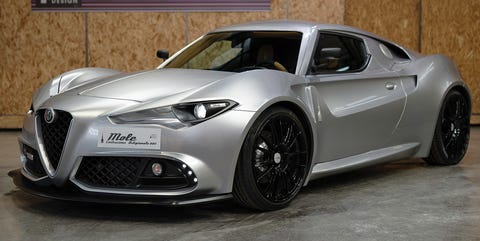
If for some reason the normal Alfa Romeo 4C doesn’t look cool enough to you, don’t worry—we might have something better. This is a one-off custom-bodied 4C, and it’s coming up for auction next month at RM Sotheby’s Lake Como auction. It has a striking look with an aggressive take on Alfa design language, and you can own it.
This car, dubbed the Mole Handicraft Construction 001, was built in 2018 after former FCA CEO Sergio Marchionne revealed there would not be a successor to the current Alfa Romeo 4C. The donor car was a 4C coupe that had previously driven 40,000 kilometers (around 25,000 miles). The coachwork was penned by Umberto Palermo of Up Design, and adds some angry muscularity to Alfa’s mid-engine sports car. The headlights are similar to the items used on the Giulia sedan, while the rear reminds me of something from Zagato. The wheels have been replaced with multi-spoke aftermarket units, and the number of exhaust pipe exits has doubled from two to four.
Underneath, the car is still very much a 4C. A 237-horsepower 1.75-liter turbocharged inline-four powers the rear wheels via a six-speed dual-clutch transmission. The interior has been fit with two-tone premium leather, and looks great.
The car will come up for auction at RM Sotheby’s Villa Erba event on May 25th in Lake Como, Italy. There’s no sale estimate listed, but considering this car is the only one of its kind, we’re betting it’ll be a bit more expensive than a normal 4C.
By: Brian Silvestro, April 29, 2019
For more cars, visit: https://www.roadandtrack.com/car-culture/a27309775/one-off-custom-alfa-romeo-4c-for-sale/
Source: https://www.roadandtrack.com/
VW Reckons Its ID R Could Do a Sub-6 Minute Lap at the ‘Ring
Remember the first pictures of the Nürburgring-spec Volkswagen ID R prototype that we brought you last week? Well it turns out that it’s really, really quick.
You know the story by now. Having smashed the Pikes Peak record by over 16 seconds last year, VW has adapted the car to take on the ‘Ring and the current EV record of 6m 45.9s (set by the 1,341bhp NIO EP9).
After a rather short three-month development period, driver Romain Dumas was able to get behind the wheel for some initial testing laps at the Green Hell for the first time on Thursday. And if simulator runs are anything to go by then the ID R could take almost a minute off the NIO’s time.
Dumas has already set a virtual time of 6m 06.17s, but VW has made its sim available to the world via Raceroom and times have been tumbling. At the point of writing, the quickest lap stands at a rather incredible 5m 56.6s. Romain has some work to do…
Welcome to the Hennessey VelociRaptor Ranger
America was very happy when Ford announced the Ranger would return to the USA. And it was even happier when the company announced it would do a ‘Raptor’ version. But then its hopes were dashed, its dreams crushed, when Ford announced the Ranger Raptor would not be sold in the States.
Well good news Americans, for John Hennessey has your back. He’s taken the American version of Ford’s littlest truck and created this – the Hennessey VelociRaptor Ranger.
Power comes from Ford’s 2.3-litre turbocharged four-cylinder petrol engine. Stock it makes 270bhp and 310lb ft, but a less restrictive, better sounding stainless steel cat-back exhaust and some ECU tuning mean the VelociRaptor makes 360bhp and 440lb ft. 0-60mph takes 4.9 seconds – two seconds quicker than stock, and faster even than a stock F-150 Raptor. Ford’s own Ranger Raptor, which uses a four-cylinder diesel engine, takes over 10 seconds to hit 62mph.
Hennessey’s ‘Stage 1’ suspension kit lifts the Ranger by four inches. 18-inch alloy wheels and BFG off-road tyres add a bit more height, so in all the VelociRaptor Ranger is six inches taller than standard. You also get a more aggressive front bumper with built-in LEDs and you can spec a winch.
Prices start at $64,950 – or just under £50k. That’s only about £1k more than Ford’s own Ranger Raptor. Only 500 will be built in 2019 so, Americans, get your order in quick.
By: Tom Harrison, April 30 2019
For more cars, visit: https://www.topgear.com/car-news/usa/welcome-hennessey-velociraptor-ranger
Source: https://www.topgear.com/



